COURT LEWIS resides on 12 acres of mixed pasture and woodland, 1,900 foot elevation, near Unicoi, Tennesseee, within Cherokee National Forest. One part of the property has a steep ravine, forested on both sides, with clay-loam soil. The dominant canopy tree species are tuliptree, oak, locust, dogwoods, white pine, and hemlock.
He first received seeds from Torreya Guardians autumn 2015. By 2024, his 3 largest torreyas ranged from 6 to 9 feet tall (two of them below left).
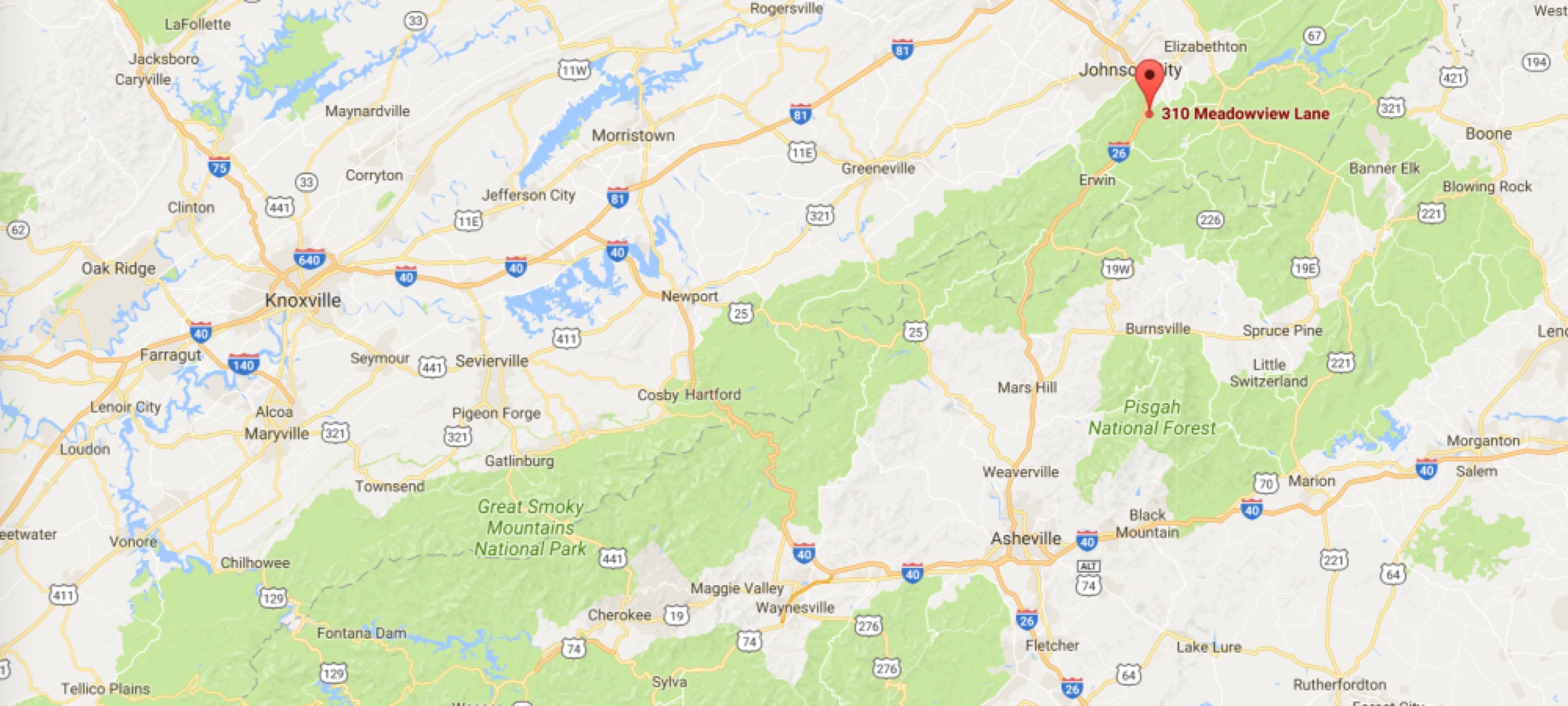
Photo REPORTS in chronological order
Court Lewis received his first set of seeds in November 2015. He decided to use the can technique (with bottom of can removed), as suggested by Jack Johnston on the Torreya Guardians propagate page. He planted his seeds January 9, 2016.
"I buried the cans about 2/3 in the ground, with the top third above-ground and with a hardware-cloth metal screen over it to protect the shoot while also giving it room to grow. The bottoms of the cans were cut out. The soil in the pots was at surrounding ground level. The seeds were about 2-3 inches below the surface, so they got whatever rain and groundwater the surrounding plants did."
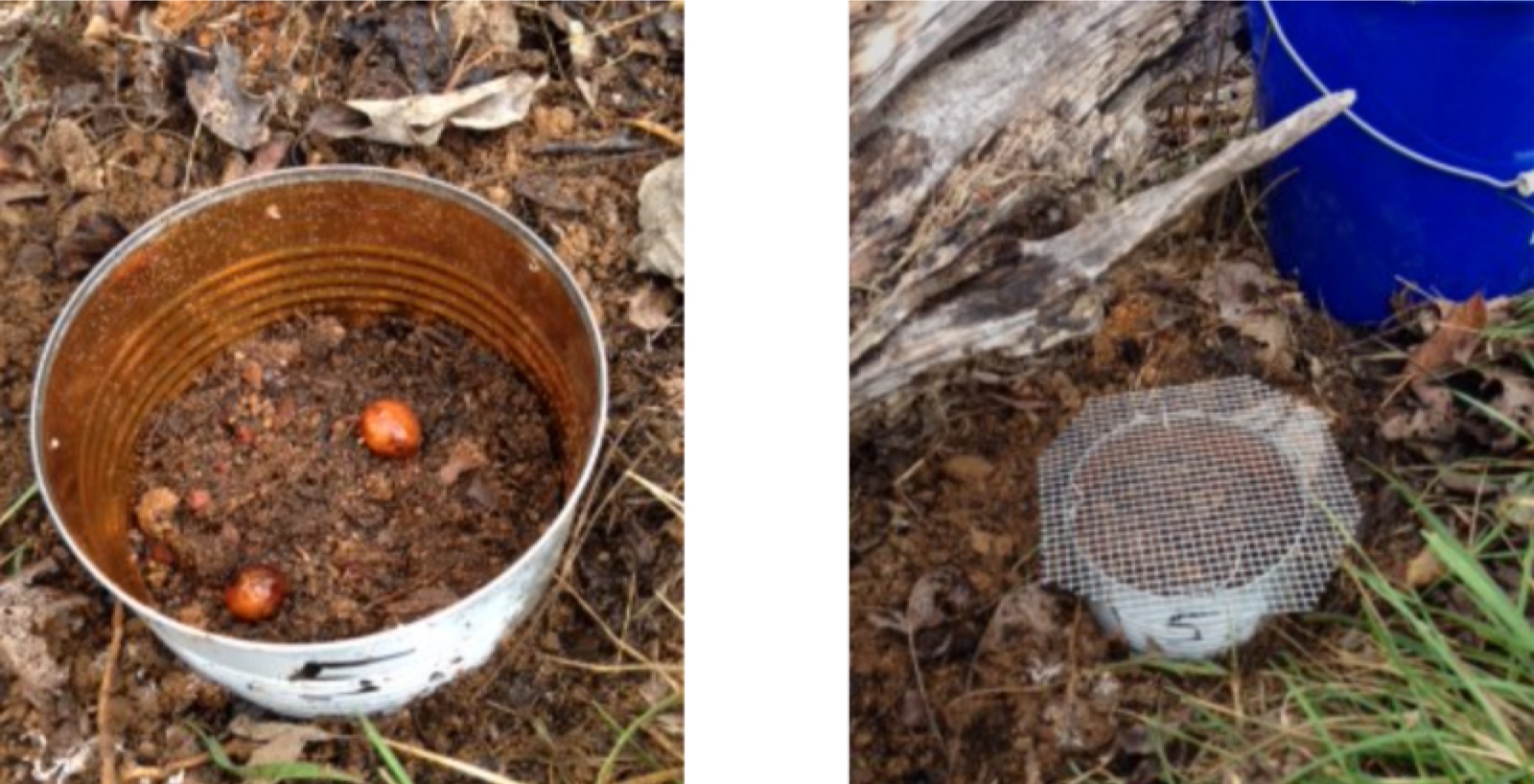
ABOVE: Photos by Court show his final stages of planting.
Read his detailed methodology (with more photos) here in PDF. He planted 2 seeds per can — one scarified and the other not. His results will help us evaluate the benefits of scarification.
30 seeds were planted in this fashion, 2 per can. "Five additional seeds are planted without cans — but 5 inches deep, well below the frost zone, so it will be interesting if they show different results from the other 30 (and whether rodents can detect them at that depth)."
CHRONOLOGICAL REPORTS by COURT LEWIS
• MARCH 29, 2016 - I planted nearly 50 seeds. We had 3 periods of subzero temps in Jan-Feb. It'll be interesting to see if scarification makes a difference. At least with my cans [protected by wire on top], I know the seeds are still in the ground and not eaten.
• NOVEMBER 14, 2016 - I've checked on a number of my seed pots recently and none have sprouted so far. (It's been about a year.) I dug up one seed and it looked about like it did when I planted it. But we had a drought this summer and fall, and since nearly all are a little hard to get to, I didn't water them. I'm sure that didn't help. Anyway, that's my status report.
• MAY 2017 - Lee Barnes sent him 50 more seeds from the fall 2016 harvest in Medford, OR.
• MAY 23, 2017 - Nothing so far. It's been about 18 months, but a lot of that was very dry. The pots are too far from the house and too hard to get to for me to water them. But I would hope I'd get at least one!
• JUNE 11, 2017 - I was weed-eating yesterday in one of the areas where I had planted my pots back in early January 2016. The pots were totally covered in weeds. But lo and behold, when I dug them out, there were bright green Torreya seedlings bumping up against the bottom of the wire mesh covers. So I checked them all (data below).
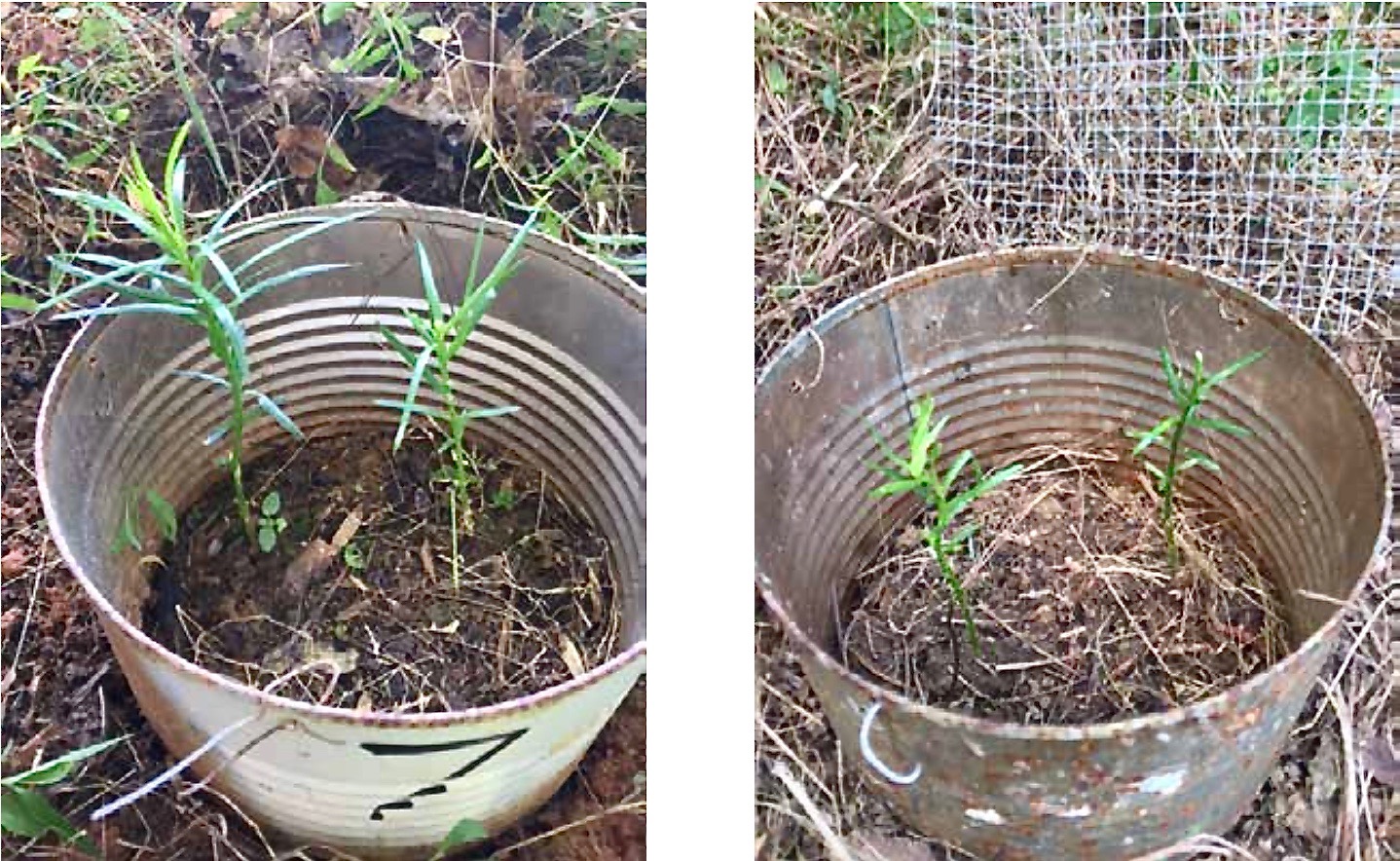 |
|
LEFT: Two of the buried pots (each with 2 seeds in it).
The seeds had been buried under 1-2 inches of soil in the cans. They sprouted in all kinds of locations — steep slopes, fairly flat ground, wet ground, drier ground, sandy soil, clay soil. The surprising thing to me was that after 18 months all the cans were totally covered with weeds and pine needles (it was hard to find several of them). But under that cover, the seedlings were green and healthy. (I wished that I had marked the cans with a flag, but when I planted them in January the cans were easy to see sticking up above the weed-free ground.) |
I was lucky to look for them when I did, because they were just hitting the wire mesh; a few had grown a little bit through it but the mesh could be removed without damaging the sprout.
• JUNE 11, 2017 DATA (of the seeds planted January 9, 2016):
INITIAL CONDITIONS: Of the 18 buried cans, 12 had two seeds planted and 6 had one seed planted. Of the 12 pairs, 8 cans had one scarified seed and one not scarified.
JUNE RESULTS: 16 of the 18 cans had at least one seedling. I could not access one can; it was buried under a recently fallen tree and covered with poison ivy vines and other debris.
In 3 of the 12 cans with two seeds, both had sprouted. Out of the other 9 cans (one of these was the one I couldn't find), where only one had sprouted so far, of the two where I could see the seeds, both were the scarified seeds.
FREE-PLANTING (directly into ground) RESULTS: I also had planted 4 seeds directly into the soil, 5 inches deep, with no pot and no wire screen (marked with flags). None of those have sprouted so far. At one marked site I found a clear vole hole.
So I have a total of 18 healthy seedlings.
PHOTOS of ALL OF THE SEEDLINGS are shown in this pdf of photos.
We're getting enough rain. I cleared out the ground cover around each pot and removed the wire mesh.
• JUNE 29 & JULY 5, 2017 - This past winter was freakishly warm here. Maybe got into the low teens once or twice. Many days in the 60s and 70s. One decent snowfall, in early November I recall. So maybe it was just enough to give them the cold cycle they need, but not enough to kill the shallow roots as the seeds started to sprout in the warm periods.
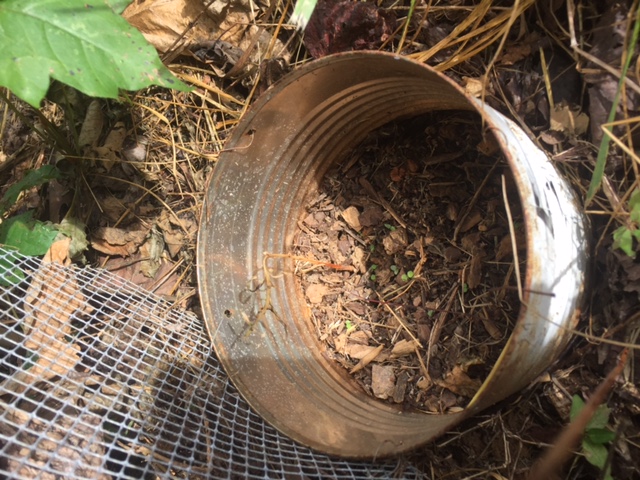 |
| 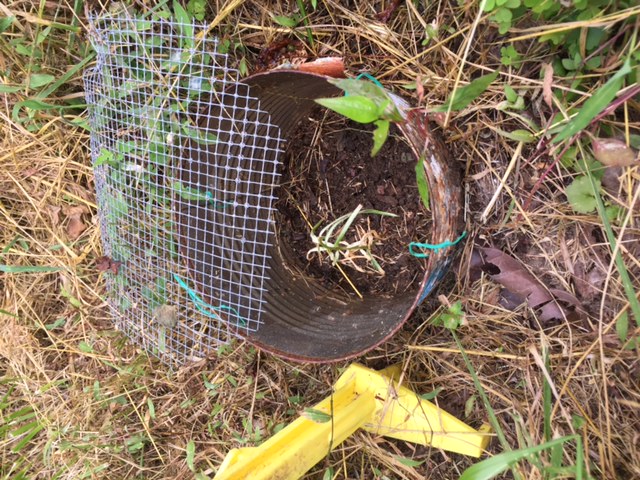 |
|
PHOTOS LEFT: After I removed the cover of weeds from the cans and took off the wire mesh cover so they could continue growing, we had a dry, hot spell. Three of the seedlings were burned by the sun and dry weather after being uncovered and died. (They were the ones in pots that were most exposed to the full sun all day long.) So I have a total of 16 healthy seedlings.
None of the free-planted seeds have come up yet, that I can see.
|
Editor's note re sunburn: Torreya taxifolia is a slow-growing evergreen tree. Its needles will be used for photosynthesis for 3 or more years before dropping off. Because the tree furnishes each leaf with UV-sun protection chemicals that match the conditions of its first season, the existing leaves will sunburn (and sometimes die) if substantially more sun enters the site in subsequent years. Bottom line: Ensure that the seed germinates in conditions not unlike those in which it will ultimately be placed. Consult the Shade Or Sun? section of our "Propagate" page.
• JULY 31, 2017 - Important result: Seed planted 5 inches deep produces seedling.
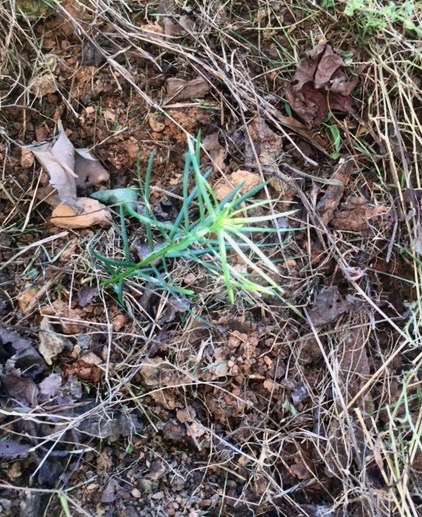 |
|
I had begun to think that the 4 seeds I had planted without protecting cans had been eaten or were too deep. But they've just started coming up. I had them at 5 inches deep compared to 1-2 inches in the rodent-protected cans, so it just took them longer. Also, lately we've been having heavy rains, after a long dry period. Torreya seems to like our orange clay-rich soil in East Tennessee.
The one (photo left) that has above-ground growth is in the sunniest location, less surrounded by weed overgrowth than the others.
Notes from Connie:
• Court received seeds in the fall of 2015, from the harvest that year.
• I began advocating in 2015 for seed planters to experiment with out-planting seeds directly into final locations in forest habitat, unprotected, except for testing whether 5 or 6 inches deep might be adequate for preventing rodents from detecting them, while still allowing the germinating seeds to rise up to the sunlight.
|
This is the first report of successful experimental results for free-planting seeds at great depth (5 inches).
• AUGUST 1, 2017 - I used a 50/50 mixture of native clay soil (from the hole in which I was planting the seeds) and Scott's topsoil as the planting medium, so culture shock shouldn't be a problem. Counting 7 no-shows in a can, one lost can, two killed by a deer stepping into the can, 3 dying of sun/drought, and 3 deep-plantings that haven't surfaced yet, I have 17 healthy seedlings out of 34 seeds planted — a 50% success rate (so far).
• SEPTEMBER 18, 2017 - Two of the cans with no-shows each produced a late-appearing seedling. As well, of the 2 seedlings that appeared to have died of sun-scald this past spring, one had regnerated. Hardy little bugger! So now I have 20 seedlings. In the one can where the seedling had really died, I planted 2 new seeds at a depth of 2 inches, since it has a covering to guard against rodents.
Update on the seed-depth experiment: A total of 4 seeds were planted 5-inches deep; of these only 1 shows above-ground growth thus far. We've had a long dry spell, and seeing that Lee had packed the seeds he sent me this past spring in wet moss, I left them in the box until it got cooler. I just planted them this weekend — not in cans this time, but 3 to 5 inches deep in many varied locations directly into the forest, marked with a flag. I'll check them starting next spring.
• APRIL 2, 2018 - This weekend I transplanted three seedlings that were growing two-to-a-pot into three cans where none had sprouted. The bottoms of the cans are cut out and the roots are growing several inches into the regular soil, in a variety of places in the woods. The photos show the transition of one from can #7 to can #9. I'll keep an eye on them and see how they do. They were planted in December 2015 and sprouted a year ago. They're all about 4 to 6 inches high now. Growing slowly, despite plenty of rain.
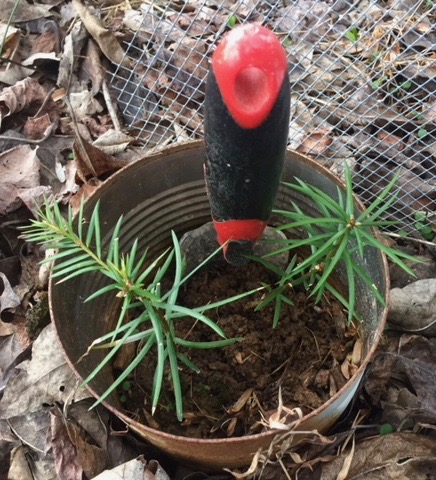
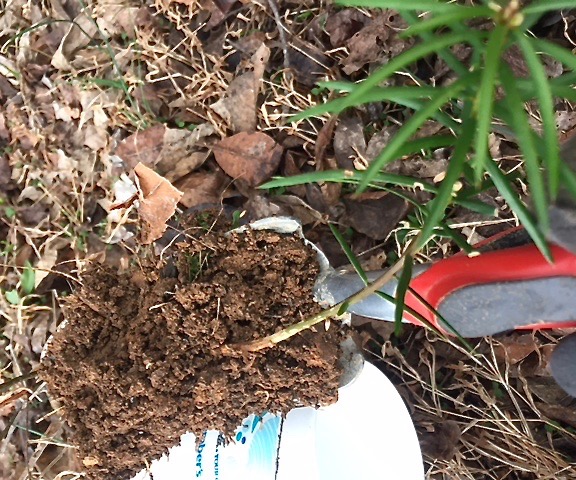
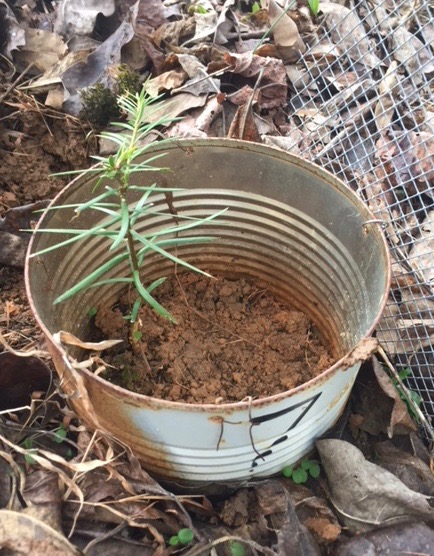
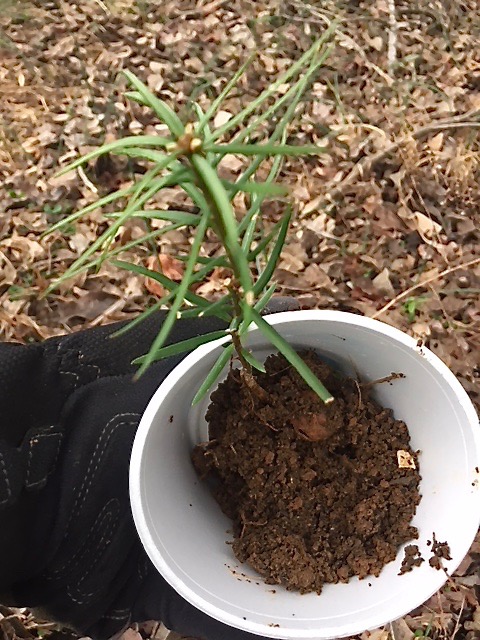
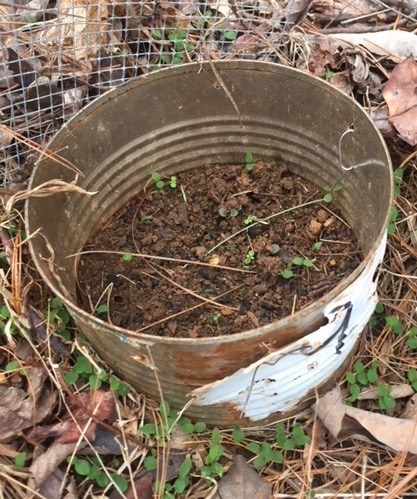
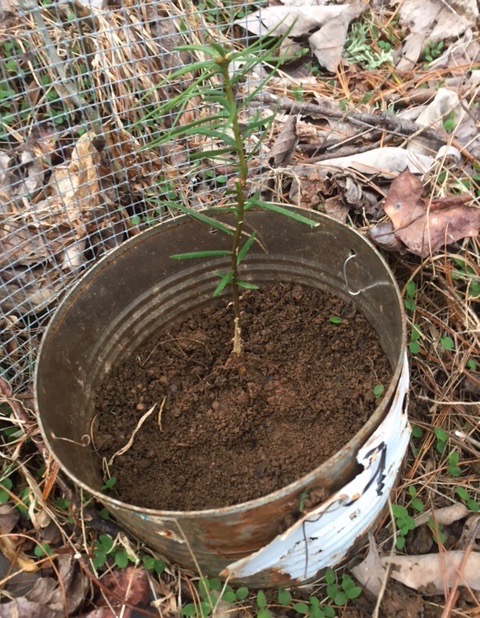
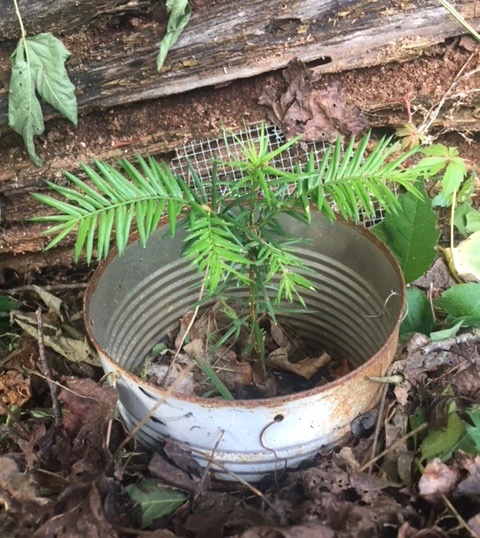 |
|
• JUNE 2, 2018 - The young ones growing in bottomless cans in the woods are doing well. I transplanted several from cans where there were two-to-a-can, where none had sprouted, or they had died from drought or from being stepped on by deer. Meanwhile we've had rain nearly every day for a month, so they're thriving and some of those I thought had died have experienced resurrection and life. Here's a photo of one of the best-growing ones from this morning.
None of the seeds I planted at different depths in the ground in September have sprouted yet, as far as I know. But they're getting covered by weeds and ground cover, unlike the ones in the cans, which are protected to a great extent by the cans.
• SEPTEMBER 24 UPDATE: "... I currently have 21 seedlings (not 17), due to some late bloomers since that tally was made."
|
• JANUARY 27, 2019 - We've had an absolute monsoon here since last spring — 10 months in which it has rained (or lately, snowed) nearly every day. 2018 broke all records for rainfall here and across the whole region, going up into the Mid-Atlantic. As a result, a number of the seedlings in cans have died. (Again, the bottoms of the cans are open, so that's not a factor.) When I pulled a couple out to look at them, the roots were rotted, along with the foliage.
That's the bad news. The good (and kind of surprising) news is that the 20 or so SEEDS THAT I PLANTED 3" TO 5" DEEP in Sept 2017 (no cans; seed source Medford OR 2016 harvest) have started to sprout: about half of those I looked at yesterday. The winter here has alternated between unusually warm (and wet) and below-normal temps, as low as 6 degrees F. So I'm surprised they're coming up after 15 months, and in mid-winter. Hopefully they'll manage the cold and flourish in the spring. P.S. It occurred to me that probably the reason they're sprouting sooner than usual is because they spent 5 months packed in wet moss in a dark closet, so they got a head start.
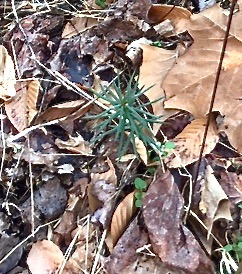 |
|
 |
|
• MARCH 27, 2019 - The new SEEDS THAT HAVE SPROUTED aren't really growing much. In fact, only two of the many that have started have actually grown to even close to a foot in height. They live but don't seem to thrive. I think they don't like this dense red-clay soil. Do your other Guardians in red-clay areas have any better luck?
Editor's note: The photos COURT LEWIS provided show the usual growth forms and size of newly germinating seeds. A significant amount of root growth (thus invisible on the surface) is important for full establishment of the new seedling.
|
CONNIE BARLOW RESPONDS (MARCH 29) TO THE ABOVE: Thinking about your situation, let's begin with the fact that you got months of rain. Clay soil is a problem if you planted on the flats. Either the trees roots or the mycorrhizae it depends on that make the root hairs must have drowned. Do you have a slope that you can transfer them to?
Folks in the panhandle of Florida periodically use agricultural lime on their trees when the yellowing begins.
Whatever happens, if you can keep close tabs on how your trees fail (document exactly what is going wrong) and especially if some of your trees don't fail, then your planting will be a success overall for the species because we will have learned something we can pass on to others. Our plantings in a variety of latitudes and landscapes is probably the best thing we do that the official program does not do. It means we can learn.
For example, we learned that 2 places I videoed showed zero herbivory: one of the free-planted seeds into seedlings and the other of the outplanted potted seedlings. This species cannot be delisted until we learn where and how to release it into the wild. So if you have mixed results that we can isolate to differences in some aspect of habitat, that will be really useful.
COURT LEWIS RESPONDS (MARCH 29) TO CONNIE: All our property is on a slope, ranging from 10% to 35%. The amount of rain this year was historically unprecedented. The ground everywhere was saturated for months and never really froze all winter.
If I had to use lime (or fertilizer) on the seedlings periodically, it would just be a form of life support that means the location here is unsuitable for them. [Connie agrees!] I think the ones that live will be the survivors of natural selection, which is as it should be.
There's no rhyme or reason that I can see as to which ones are doing OK vs. dying. Ones 10 feet from each other are doing one or the other. Actually, the ones on the flatter slopes might be doing better. If I can see any pattern at all, it's that those that get more sunlight are doing better, but not all of those by any means. It might have something to do with the composition of the soil below my prepared hole in individual spots, which could vary for short spaces in any number of ways: a long-rotted branch down below, a nearby tree root running close by, being near a chunk of limestone in the ground, etc.
Only about half of the seeds that I free-planted in Sept 2017 are up. Maybe more will sprout soon, we'll see. Out of the roughly 60 that I've planted, all told (some being replantings of seeds in cans where the original one(s) died or didn't sprout at all), around half are up and still alive. I'll keep track of those and the unsprouted ones and keep you updated periodically.
• 28 AUGUST 2019 UPDATE (from Court Lewis): "Hi Connie. The webpage on my activities looks good. I'm sorry to have to report that the Torreya seedlings have just not thrived in our local clay-ey soil. They start out looking promising but then all stall at about 10 inches in height. My guess is that's when they run out of the topsoil/clay mix I put below the seeds in the can and have to subsist on the actual local soil. They just stop growing and eventually begin to suffer from whatever comes along — too much rain being the most prevalent problem. I get nothing like Clint's results, which are great."
• 12 MAY 2020 UPDATE: Court Lewis reported that surviving Torreya on his property number about 15. He sent photos of his two best specimens, while concluding, as before "They just don't do well in this clay soil." He explains, "All but one of those quit growing when they hit the edges of the ameliorated soil I put in their pots and have just been staying alive at the same size for the past 2+ years." Here are the PHOTOS with captions he wrote for these two best specimens:
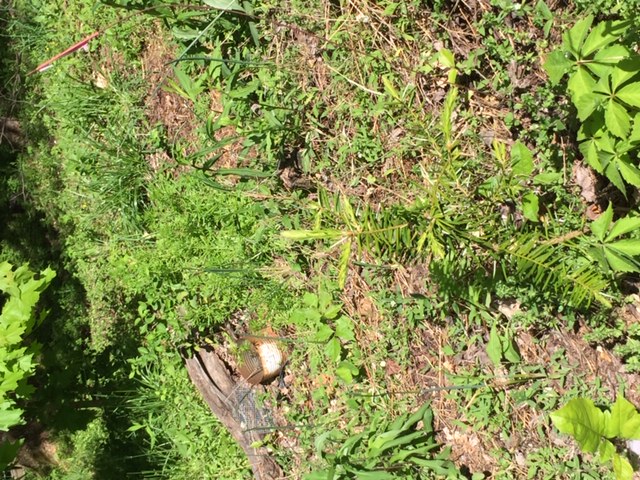
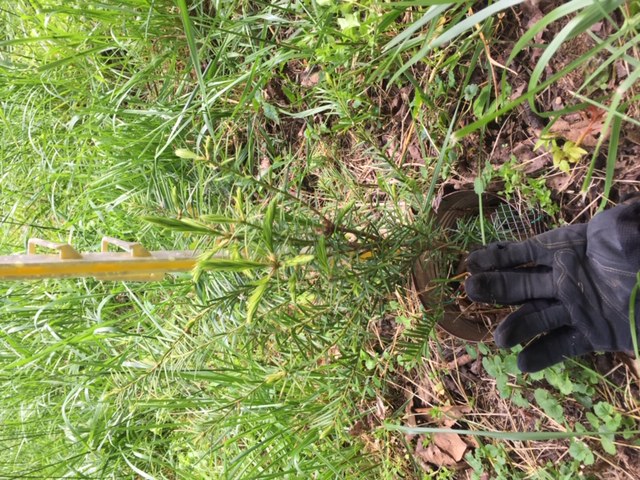
PHOTO LEFT: "This seedling, free-planted as seed in January 2016 at 5 inches depth, was first seen in late July 2017 at 2-3 inches high. It is the only one of the free-planted seeds that actually grew from a deep planting with no protection and lived. It's now about 16 inches tall, with several side branches and the appearance of buds and new growth at the tips. It is planted two feet from the top of an east-facing slope in hard orange clay. But that slope faces into a forest. To the west is our backyard lawn, so it gets full sun for at least 6 hours a day. It's possible (but not too likely) that it benefits a little from the once-a-year fertilizing of the adjoining lawn. Drought is never a problem — more the opposite. Around here it has rained on average every other day for the past 3 years. 2018 and 2019 were both record rainfall years. I think that most of the ones that died were drowned in this non-percolating clay. Being on a slope in the sun might have protected this one from over-watering more than those with more canopy cover. In the TOP OF THE PHOTO you can see a sprout in a can that is farther down-slope and is the "stalled" size of most of the others planted in January 2016 and still surviving in their bottomless cans."
PHOTO RIGHT: "Here is the best one that's growing in a bottomless can. It also is about 16 inches high, and has new growth at the tips. Out of the five cans that were originally in this immediate area, it’s one of three that remain. One is a little smaller than this and the third one is only a few inches high. They are all in a north-facing slope but get sun most of the day. Soil is slightly more loam than clay."
• 9 AUGUST 2020 UPDATE re seedling above photo left: "This one free-planted seedling is the best one I have and has grown about 6 inches since mid-May, to about 22 inches.... Alternating rainy hot weather and dry hot weather this summer seems to have agreed with it. I have a theory with regard to the unsuitability of red clay for growing Torreya. Since this seed was free-planted, without the ameliorated clay/topsoil mix in which my 'canned' plants were planted, I wonder if, given suitable conditions otherwise, the plant adapts from birth to the clay soil and can thrive somewhat — compared to the more pampered specimens, which stall and eventually die when their roots run out of the ameliorated soil and have to cope with straight clay. The only other seedling I have that is approximately this big is in a can, but is also planted on a relatively well-drained and mostly sunny slope on which the soil is more loamy and not straight clay."
• 13 JULY 2021 UPDATE - 3 PHOTOS: "I only have 4 specimens that are doing well, but they're growing very slowly. Torreya doesn't like red clay. The four are all growing in more loamy soil. The free-planted one (photo left below) has grown maybe another 4 inches in the past 14 months. The other two ("ravine" photos below) have done better — the largest one being nearly 3 feet now.
 |
|
• JUNE 2023 UPDATE:
"Here is a photo of the two biggest specimens I have.
They're both about 6 feet tall, although it's hard to tell that since they're surrounded by grass that I've let grow too high.
I only have a total of 5 survivors out of 34 planted 6-7 years ago.
The one that grew out of a free-planting in the soil is the third largest (not pictured here). It's about 4 1/2 ft tall.
Two others are smaller: 1-2 feet."
All of mine that have thrived are on sloping ground. But what I think is probably more important is that in those locations the soil isn't just pure Tennessee red clay, but is ameliorated by years of leaf mulch into something more like regular dirt. Also, in one case the location is just downhill from where horses poop, so that the nutrients from manure might seep down to them, and in the other just off the edge of a lawn that I fertilize twice a year, so that the same thing happens with the fertilizer. In both cases they get at least 6 hours a day of direct sun. I really do think they don't like pure clay.
|
__________
ABOVE: Time sequence of the same torreya grown from a 5-inch-deep free-planted seed in January 2016, which first appeared above ground in late July 2017, as 2-3 inches tall. LEFT (MAY 2020) 16 inches tall. MIDDLE (JULY 2021). RIGHT (JUNE 2023):
"It's very healthy, about 4 1/2 to 5 ft tall and is producing some buds. In the past year that one has really "found its calling." We had a relatively warm and wet winter — no snow, one night of 1 degree and another of 11 degrees, but many in the 60s and even low 70s. The two others big ones in a different location also grew more in the past year than ever before."
Note: It is planted two feet from the top of an east-facing slope in hard orange clay. But that slope faces into a forest. To the west is the backyard lawn, so it gets full sun for at least 6 hours a day.
• AUGUST 2024 UPDATE:
ABOVE LEFT: These are two trees growing close together on a slope in nearly full sun and in soil that is more loamey than the clay that's mostly in the ground there. The closest one is about 7 feet tall. The one a bit farther back is 8 to 9 feet tall. Both are very healthy.
ABOVE RIGHT: The pair of trees viewed from another angle; shortest one in front.
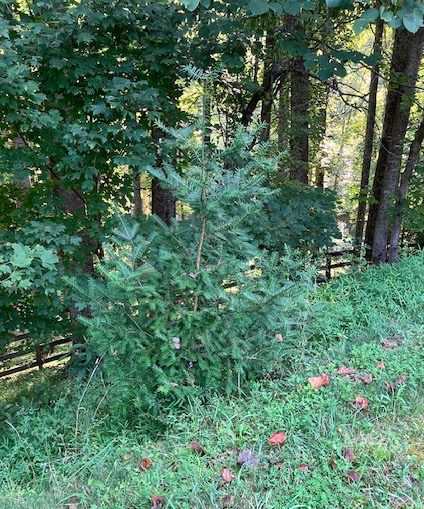 |
|
This is the third tree that has thrived (out of 34 seeds originally planted).
It's the one that grew from a seed that I free-planted 6 inches in the ground.
It's on the edge of a slope off our back yard in half-day sun and in soil that is more loamey than the prevailing clay. It's 6 to 7 ft tall and very healthy.
I just don't think they like red clay. Maybe too acidic?...and/or too hard to get their roots into?
|
Return to HOME PAGE